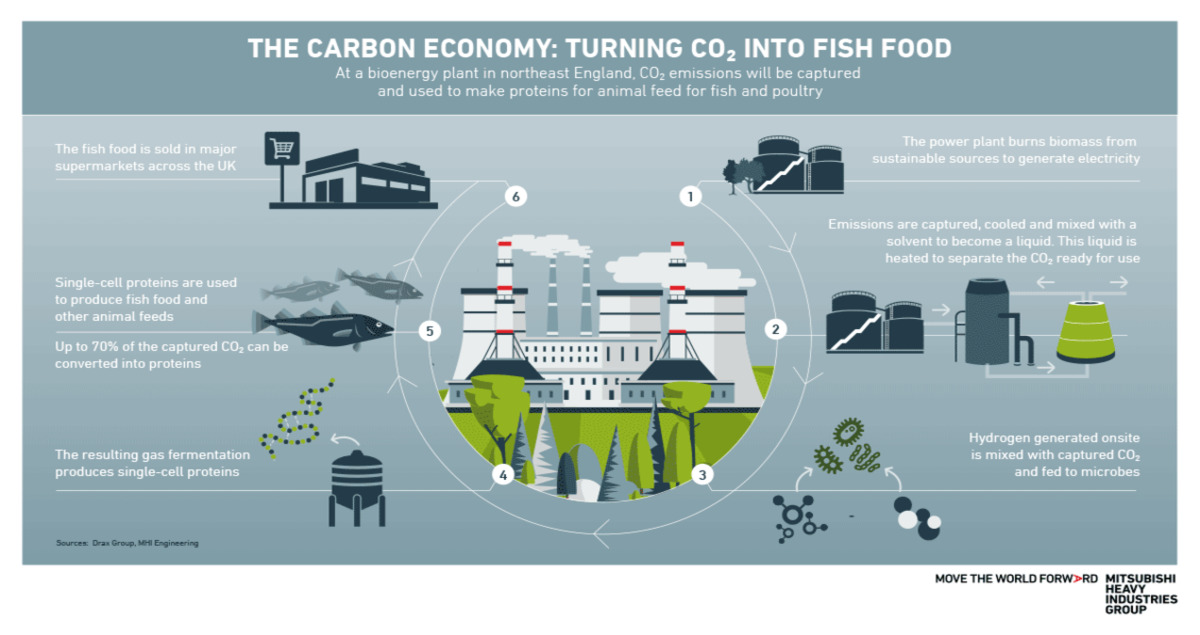What is the CO₂ value chain and why is it key for net zero?

Index
The term “CO₂ value chain” is increasingly part of the conversation around the drive to reach net zero emissions, but what does it mean and how can it help energy and industry efforts to decarbonize?
The answer to these questions is linked to the growth of carbon capture, utilization and storage (CCUS) technologies, which harness CO₂ from industrial flue gases. But as new carbon dioxide capture projects spring up across the globe, they face the challenge of what to do with their captured CO₂.
The bulk will need to be stored securely deep below ground. But there is also scope to create a value chain for some captured CO₂ and turn it from a liability into a tradable asset. Here, we go behind the scenes to explain what a CO₂ value chain is, why it is important and the solutions that can make it work.
What is meant by the term ‘CO₂ value chain’?
Captured CO₂ can be used in a number of industrial applications — from putting the fizz in carbonated drinks, to manufacturing cement. This makes it a tradable commodity with its own market value.
And like other tradable goods, CO₂ is also part of a bigger value chain — a cycle that includes new infrastructure to make a record of the captured gas, as well as bespoke transport and storage solutions.

How does it work?
Deploying carbon dioxide capture solutions to prevent industrial CO₂ emissions reaching the atmosphere is only part of the story.
To utilize this CO₂, the gas must first be transported from the capture site to the end user, either by a pipeline network — like those used in industrial clusters — or by ship.
Moving it by ship first requires the carbon dioxide to be transformed into liquefied CO₂ (LCO₂). This then has to be piped to an LCO₂ carrier and loaded ready for transport. Once the ship arrives at its destination, the LCO₂ is turned back into a gas and stored or used in various industrial applications — as shown in the video below.
What examples are there of the CO₂ value chain in action?
Carbon dioxide capture technologies are still at a relatively early stage. Most current projects harness emissions from large-scale power plants and industrial clusters, then transport the CO₂ to secure geological storage sites deep below ground or beneath the seabed.
However, the beginnings of a value chain are also emerging. One example is a joint feasibility study by Mitsubishi Heavy Industries (MHI) Group and three other companies in Japan for a large-scale CCUS value chain project using ship transportation to help decarbonize hard-to-abate industries.
What role could the value chain play in a net zero society?
Carbon dioxide capture technologies can extract more than 90% of CO₂ emissions from fossil fuel-fired power plants and industrial processes.
Integrating capture systems with pipeline networks and storage sites, as well as using digital connections to track and facilitate end-to-end transactions, can support both CCUS technology and broader decarbonization efforts.
Which industries can this help to decarbonize?
It’s important to note that CCUS is not a cure-all for climate change and will not remove the need to transition from fossil fuels to cleaner forms of renewable energy.
However, as part of the wider CO₂ value chain, CCUS can help some hard-to-abate industries decarbonize their operations. CCUS solutions and infrastructure can be fitted to production sites in various industries, including cement manufacture, steelmaking, aluminium production, power generation, waste-to-energy plants and LNG liquefaction facilities.
Captured CO₂ is currently used by a number of industries, including for enhanced oil recovery (EOR), producing synthetic fuels, making construction materials like cement and aggregates, as well as in the manufacture of fertilizer, plastics and chemicals.
What CO₂ value chain solutions are in development?
Several innovations could help a global CO₂ value chain operate at scale.
Mitsubishi Shipbuilding’s CO₂L-BLUE LCO₂ carrier could provide a cost-effective way to meet growing demand for transporting LCO₂ to end users or storage sites. A test vessel was recently launched at the Shimonoseki shipyard in Japan, to develop and demonstrate technologies for safe and low-cost LCO₂ transport.
Modular designs for CO₂ capture systems have been developed by MHI for small and medium emitters to help reduce costs and shorten delivery and installation lead times.
MHI is also developing its CO₂NNEX Digital Platform to digitalize the CCUS value chain, so it can operate in a similar way to other utilities like electricity, water and gas. CO₂NNEX will also increase the transparency and accountability of the end-to-end journey of captured CO₂ molecules.
The digital platform connects players along the entire value chain, including CO₂ emitters, sellers, buyers and investors, LCO₂ producers, distributors, aggregators, intermediate storage and sequestration providers.
How could the value chain contribute to the circular economy?
CO₂ captured from power plants and industry can be used to promote the circular economy.
In the UK, energy company Drax is aiming to convert up to 70% of the CO₂ captured from its biomass power plant into single-cell proteins used to produce fish food and other animal feeds, for example.

Another biomass power plant in the Japanese city of Hiroshima aims to use CO₂ captured from its flue gases to help grow plants. This would both remove carbon dioxide from the atmosphere and contribute to the circular economy.
Moving from land to sea, capture systems for ships are being developed to harness maritime emissions. This harnessed CO₂ could then be stored and pumped ashore, once the ship has entered port, for use in industry.
Are there particular regions the CO₂ value chain can benefit?
For countries such as Japan, which have limited suitable natural geological storage sites, a value chain that enables captured CO₂ from domestic industries to be transported to distant storage sites or reused in other sectors could help with efforts to decarbonize.
The business case for CCUS is still developing. However, increasingly rigid climate targets and the advent of carbon pricing schemes like the EU and UK Emissions Trading Systems — which put a per-tonne cost on CO₂ emissions — could make the potential to trade captured CO₂ a valuable solution for heavy emitters to consider.
Discover more about MHI's CO₂NNEX platform to buy, sell and trade CO₂




